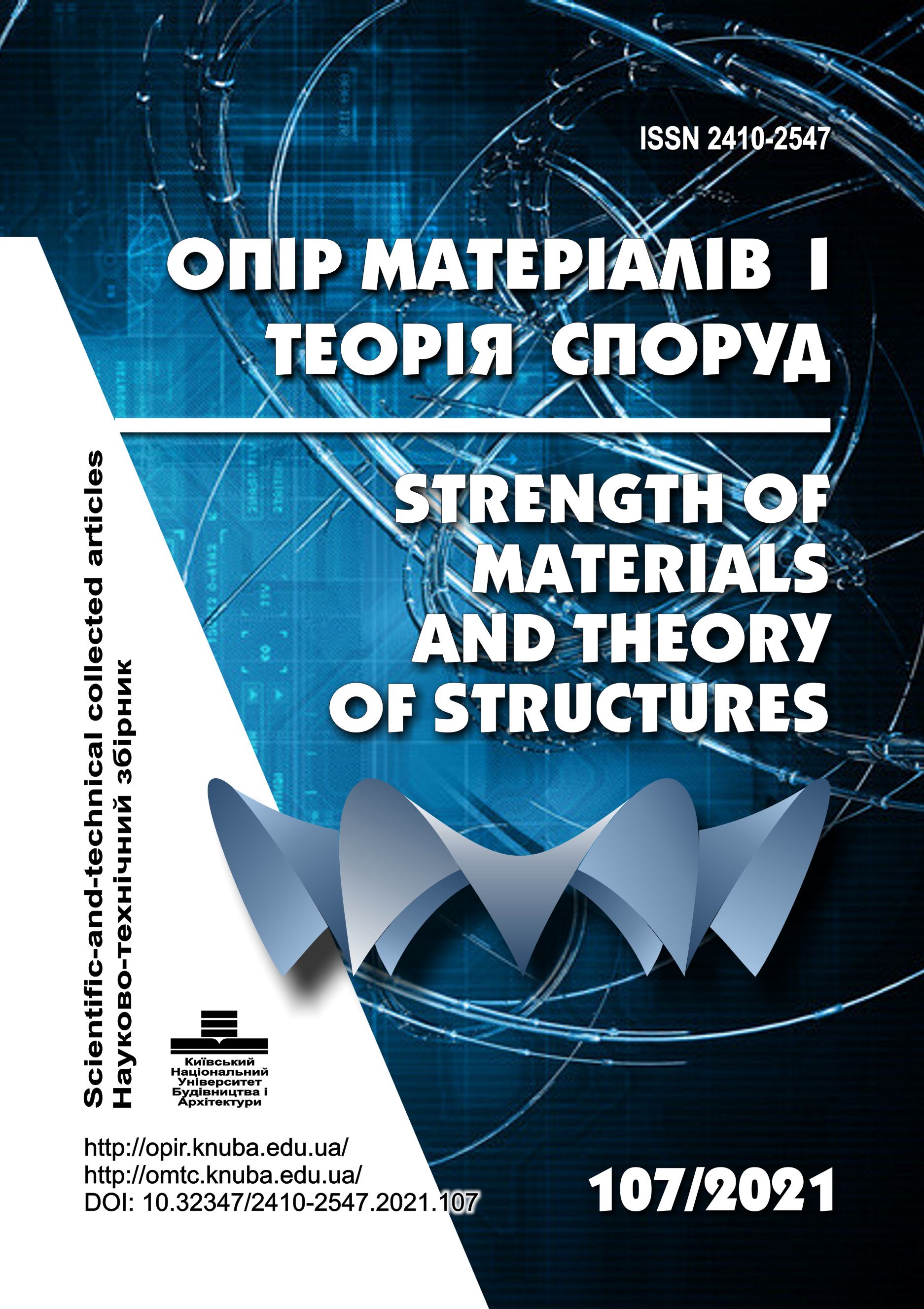Peculiarities of formulation and solving the dynamic problems of thermoelasticity
DOI:
https://doi.org/10.32347/2410-2547.2021.107.312-322Keywords:
thermoelastic medium, spherical waves, fields couplingAbstract
The problem of propagation of spherical waves in a thermoelastic medium is considered. Two approaches to taking into account the mutual influence of dynamic fields of deformations and temperature are compared. A generalized model of coupled thermoelasticity is used for calculation in the first approach and the second one is based on the ratio of the theory of thermal stresses, which are neglecting the change of temperature distribution under mechanical loads action. The amplitude-frequency characteristics of radial displacements and normal tangential stresses at the boundary of a spherical cavity being under action of load, which changes according to the harmonic law in time, are obtained. The correspondence between the value of the coupling parameter and the results error caused by the use of the simplified model of field interaction is traced. Wave processes in solids of modern polymeric materials, such as polyvinyl butyral and polyvinyl butyralfurfural belonging to the family of polyvinyl acetals, which have a fairly high coefficient of field connectivity of 0.18 and 0.41, respectively, are considered. It is shown that the use of a simplified model of coupled thermoelasticity for the calculation of structure of such materials leads to unacceptably large differences in the results. Thus, the maximum values of the stress-strained state parameters obtained using the generalized model were 18% higher than in the case of the application of the theory of temperature stresses for polyvinyl butyral. The results difference obtained using this two approaches at some frequencies exceeded 30% for the polyvinyl butyralfurfural medium. It is concluded that the simplified model of the interaction of deformation and temperature fields can be a rough approximation in the analysis of the dynamic reaction of massive structural elements made of such materials.
References
Danilovskaya V.I. Temperaturnye napryageniya v uprugom poluprostranstve, voznikayushchiye vsledstviye vnezapnogo nagreva ego granicy (Thermal stresses in elastic half-space that occur as a result of sudden heating of his boundary). // Prikl. math. i mech. – 1950. – V.14. – № 3. – P.316-318. (rus).
Danilovskaya V.I. Ob odnoy dinamicheskoy zadache termouprugosti (On a dynamic thermoelastic problem). // Prikl. math. i mech. – 1952. – V.16. – № 3. – P.342-344. (rus).
Parkus G. Neustanovivshyesya temperaturnye napryageniya (Non-stationary thermal stresses). – М.: Fizmatgiz, 1963. – 252 s. (rus).
Boley B.A., Weiner J.H. Teoriya temperaturnyh napryageniy (Theory of Thermal Stresses). – M: Mir, 1960. –516 s. (rus).
Kovalenko A.D. Osnovy termouprugosti (Basics of thermoelasticity). – К.: Nauk. dumka, 1970. – 308 s. (ukr).
Nowacki W. Dinamicheskiye zadachi termouprugosti (Dynamic problems of thermoelasticity) / Edited by G.S. Shapiro. – M: Mir, 1970. – 256 s. (rus).
Podstrigach Ya.S., Kolyano Yu.M. Obobshchennaya termomehanika (Generalized thermomechanics). – К.: Nauk. dumka, 1976. 311 s. (ukr).
Gribanov V.F., Panichkin N.G. Svyazannye i dinamicheskiye zadachi termouprugosti (Coupled and dynamic problems of thermoelasticity). – М.: Mashynostroyenie, 1984. – 181 s. (rus).
Kartashov E.M., Parton V.Z. Dinamicheskaya termouprugost i problemy termicheskogo udara (Dynamic thermoelasticity and problems of thermal shok). // Itogi nayki i tehniki. VINITI. Ser. Mehanika deformiruemogo tverdovo tela. – 1991. – V. 22. – P. 55-127. (rus).
Kupradze V.D. (obshh. red.).Trehmernye zadachi matematicheskoj teorii uprugosti i termouprugosti (Three-dimensional problems of the mathematical theory of elasticity and thermoelasticity). – M: Nauka, 1976. – 663 s. (rus).
Tosaka N., Suh I.G. Boundary element analysis of dynamic coupled thermoelasticity problems // Computational Mechanics. – 1991. V. 8. – P. 331-342
Dargush G.F., Banergee P.K., Development of a boundary element method for time dependent planar thermoelasticity // Int. J. Solid Struct. – 1989. – No 25. - P. 999–1021.
Tehrani P.H., Eslami M.R. Two-dimensional time-harmonic dynamic coupled thermoelasticity analysis by boundary element method formulation // Engineering Analysis with Boundary Elements. – 1998. – V. 22. - No 3, - P. 245-250
Sladek V., Sladek J., Boundary integral equation method in thermoelasticity. Part I: general analysis // Appl. Math. Modelling. – 1984. - No 7. – P. 241–253.
Kobzar V.N., Filshtinskiy L.A. Ploskaya dinamicheskaya zadacha svyzannoy termouprugosti (Plane dynamic problem of coupled thermoelasticity) // PMM. – 2008. – V. 72. – Vyp 5. – P. 842-851. (ukr).
Filshtinskiy L.A., Sirenko Yu.V. Raschet poley v mnogosvyaznom cylindricheskom tele (Calculation of thermoelastic fields in the multiply connected cylindrical body) // Problemy mashynostroyeniya. – 2009. – V. 12. – Vyp 1. –P. 69-78. (ukr).
Igumnov L.A., Litvinchuk S.Ju., Pazin V.P. Primenenie metoda granichnyh integral'nyh uravnenij dlja analiza zadach trehmernoj dinamicheskoj teorii uprugosti (Using of Boundary Integral Equation Method for 3-D dynamic thermoelasticity problems analysis) // Problemy prochnosti i plastichnosti. – 2010. – Vyp. 72. – S. 146-153. (rus).
Vorona Yu.V., Kara I.D. Zastosuvannya metodu granychnykh integralnykh rivnyan dlya rozv'yazannya dynamichnykh zadach termopruzhnosti (Application of boundary integral equation method for dynamic thermoelasticity problems) // Opir materialiv i teoriya sporud. – Vyp. 96. – K.: KNUBA, 2015. – P. 74-87. (ukr).
Vorona Yu.V., Kara I.D. Obchyslennya syngulyarnyh integraliv tryvymirniyi teoriyi termopruzhnosti (Evaluation of the singular integrals of the three-dimensional thermoelasticity) // Opir materialiv i teoriya sporud. – Vyp. 102. – K.: KNUBA, 2019. – P. 220-231. (ukr).
Valishin A.A., Kartashov E.M. Modelirovaniye effektov svyazannosti v zadache ob impulsnom nagrugenii termouprugih sred (Modeling of coupled effects in problems of impuls loading of thermoelastic media) // Matematicheskoye modelirovaniye i chislennye metody. – 2019. – № 3. – P. 3-18. (rus).
Downloads
Published
Issue
Section
License
Copyright (c) 2022 Юрій Ворона, Ірина Кара, Марина Гончаренко

This work is licensed under a Creative Commons Attribution 4.0 International License.
Authors retain copyright and grant the journal right of first publication with the work simultaneously licensed under a Creative Commons Attribution License that allows others to share the work with an acknowledgement of the work's authorship and initial publication in this journal.

